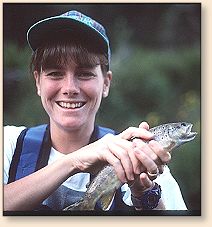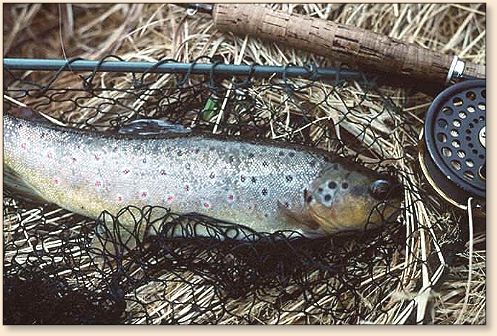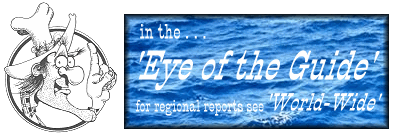Cimarron in Spanish means; wild, untamed, all good
adjectives to describe the fish and the fishing in
this river. The Cimarron is a tail water fishery:
it has its origin from Eagle's Nest Lake's dam, New
Mexico. The dam acts as a large spring for this Sangre
de Cristo Mountain fishery. Typical of any tailwater
and similar to a natural spring, the water's temperature
is regulated coming out from the bottom of the Eagle's
Nest Lake. This source of cold and nutrient rich water
produces an environment that provides an excellent base
for a superb trout fishery. The New Mexico Game and Fish
Department have done surveys and found it to contain
nearly 4,000 catchable size trout per mile. The river
has also been designated as Special Trout Waters because
of its ability to produce high numbers of good trout.
Brown trout are the principle fish species, numerically
and qualitatively, that anglers seek in this river. The
Browns are spawned, live, and die all in this fine piece
of water. Many anglers consider the Cimarrron the premier
Brown Trout Stream in New Mexico. All the fish in this
river average about a foot long but fish up to 15 and
18 inches are commonly caught. Even larger fish have
been taken by knowledgeable anglers familiar with the
river and fish producing techniques. A few Rainbow
Trout inhabit the water along the entire stretch, also.
The Rainbows are hold-over fish that are stocked at
the campground and move downstream to the Special Trout
Waters. The Rainbows grow thick and fat on the abundant
insect life. As expected, they quickly become savvy to
all the lies and hiding places in the river. Of course,
the Rainbows become conditioned to natural food and grow
selective in the taking of natural insects and therefore,
artificial flies.
The first half mile of the river from the dam downstream
is on private property and angling is only allowed by
permit (C. S. Cattle Company). Next, the Cimarron River
flows through the Tolby Campground where the New Mexico
Game and Fish stock Rainbow Trout and normal fishing
regulations exist. Then, the river passes the campground
and for the next mile and a fifth are the Special Trout
Waters. Here, the angler must fish with a single barbless
fly or lure with a single hook. There is also a size limit
of 16 inches minimum and a limit number of one fish.

The makeup of this portion the stream is a combination
of a canyon section and a nice meadow like section.
The meadow section can be found right at the beginning
of the Special Trout Waters next to the campground.
The Cimarron River meanders back and forth across the
small valley prior to entering the canyon section. Old
and active beaver dams are located throughout this section,
as are numerous bends and undercut banks. Casting in the
meadow section isn't too encumbered by the stream side brush.
The runs, meanders and beaver ponds can be fished with
relative ease. This section is normally the most crowded
with anglers on any good fishing day. If many anglers are
on the water, the fishing can be poor, not due to fish
being caught but from the multitude of poor casts and
people walking in areas where they should be fishing.
Anglers encountering a lot of people fishing this section,
may consider casting a weighted nymph in the deeper runs
and riffles.
In the canyon area walls of this valley close in on the
river. The fishing in the canyon section isn't too easy.
Overhanging trees and brush are always present to snag
the back cast or intercept an almost perfect forward
cast. Keep casting distances to a maximum couple of
rods lengths with leaders no longer than eight feet.
Wading in the center or at the edge of the river and
casting upstream is the only method that can produce
in the canyon section. Here the river is full of
boulders, riffles and snags where the trout hide and
ambush prey brought down by the current of the river.
Casting is limited to short flip cast, roll casts and
even bow casts. Difficulty in fishing this area
normally keeps the crowds away.
The angler coming to the Cimarron River should be aware
of the foam line (or 'bubble line') on the water where
insects usually get trapped and are pulled downstream.
Wild trout know these foam lines are food producers
in the river and will position their feeding lies to
intercept insects floating in or on the current. Before
casting blindly in this river, first observe the water
for a few moments and see if any trout commit themselves
as to their location. Many times a trout will reveal its
location by a disturbance in the water as it feeds.

The earliest an angler can usually begin fishing the
Cimarron is in May. But, occasionally the river can
be fished as early as March, but expect cool weather
and a possibility of snow. Water is released from
Eagle's Nest Dam because of irrigation demands downstream.
The Cimarron is a good summer river with stable water
release at 45 to 50 cubic feet a second. These optimum
flows on the Cimarron can be anticipated until October.
When other New Mexican rivers start to heat up in the
summer months causing lethargic trout, the Cimarron is
the perfect place to cast to New Mexico Brown Trout.
Fenwick's Danny Bañales and I were tossing dry flies
to rising trout on a July Fourth morning that produced
over fifty trout (all released) and a superb memory time
won't diminish. In the winter months when water is stored
up in Eagle Nest Lake, flows in the Cimarron slow to a
trickle. The fishing becomes poor and unproductive in
the dead of winter. However, if water flows from the dam
were a little more, the Browns could find more areas to
spawn and there could be a possibility of fishing through
the winter. This winter water release would also further
enhance the aquatic habitat quality of the Cimarron.
Equipment
In a river this size, a four weight or five weight rod
at or under eight feet works superbly. Longer rods may
be more of a hindrance in the canyon section. Tippets
can be 4x to 6x depending on the artificial fly and
water conditions. Hip waders with felt soles can be
used to wade the entire river with caution paid to
the many deep pools located at old beaver dams, runs
and river bends. The Cimarron is about 12 to 15 feet
wide on the average and the flow are dependent on the
water releases from Eagle's Nest Dam. Because of the
rich variety of insects in the river the Cimarron is
most effectively fished with artificial flies.
Although in the Special Trout Waters section, artificial
lures with a single barbless hook can be used to entice
fish. The key method to fish and to get strikes on the
Cimarron is to constantly work upstream. The predominate
hatches here are Blue Wing Olives and March Browns (both
mayflies), but the angler will be surprised to see other
insect species existing the water, also. Numerous caddis,
small stoneflies and midges sometimes are active right
along with other various mayfly species. On a day when
the Browns are sipping in adult insect floating on the
surface, a dry fly on a fine tippet can produce remarkable
fly fishing.
Artificial Flies
Dry fly imitations that best represent the natural insects
are; Adams, #14-#20; Elk Hair Caddis, #14-#16 in grey,
olive or tan; Humpies, #14-16 in red or olive; Stimulators,
#10-#16 in olive, orange or tan; and Comparaduns, #14-#18
in Blue Wing Olive, tan, grey and Pale Morning Dun.
Nymphs to imitate the aquatic insects include Bead Head
Pheasant's Tail, olive Caddis Pupa, Gold Ribbed Hare's
Ear, brassies and scuds all in sizes about #14 to #20.
Tie the nymph pattern on a fine tippet with a #6 split
shot about eight inches above the artificial fly and a
strike indicator four feet above the artificial fly.
If you go...
To reach Cimarron River from Santa Fe, head north on Hwy 84,
past the towns of Española, Embudo and Pilar. Arriving in
Taos, turn right on Hwy 64. There is a gas station and a
tourist information center at the intersection. Drive
approximately 32 miles to Eagle Nest Lake. The Cimarron
is about three miles from the town of Eagle Nest.
Highway 64 follows the entire length of the river. There
are numerous pullouts to park vehicles along the river for
day use visitors including a free day use parking area
next to Tolby Campground.
The Cimarron is an excellent summer river, but can be
fished as early as March to as late as November depending
on water releases from Eagle's Nest Dam. The Special
Trout Water begins at the end of Tobly Campground and
continues for one mile and a fifth, see the New Mexico
Game and Fish regulations booklet for exact information.
Camping is available at Tobly Campground, Maverick
Campground and Ponderosa Campground for a fee ($10.00
overnight camping, some water, no facilities, pit
toilets), information; (505) 577-6271. There is lodging,
restaurants, stores and other facilities at the town of
Eagle's Nest (Eagle's Nest Chamber of Commerce (800)
494-9117). Altitude is approximately 8,000 feet.
Temperatures in the summer are around 80 degrees
with the evenings becoming enjoyably cool. Expect
frequent but brief summer storms during the afternoon.
A valid New Mexico Fishing License is required by
residents and non-residents over the age of 14.
This is a wildlife area and you can expect to see deer,
elk and bear. Store your food in a safe place; trunk
of car, enclosed container, etc. Do not place food
stuff in your tent as a bear will come into your tent
for your food. ~ Thomas Peña
About Thomas
 Thomas Peña is a native New Mexican from Albuquerque.
Thomas guides on the same rivers and streams that he
fished since his youth. In addition to being a fly-fishing
guide, he also conducts fly-fishing workshops at the
University of New Mexico Getaway Services at Albuquerque
and at UNM's Community Education in Los Alamos. Thomas
Peña is a Fenwick Fieldstaffer, Berkeley Ambassador,
Hunting Retriever Hunt Test Judge and a closet Chef
among other frivolous endeavors. Thomas has fished
in the southern Rockies, California, Baja California,
Laguna Madre, Spain, England and Scotland. His other
interests are travel, academia, hunting, Labrador
Retrievers, photography, drinking beer and freelance
writing with publications in Fly Fishing Quarterly,
Dallas Morning News, Retriever Journal, New Mexico
Wildlife (where this article previously appeared) and
other local publications. When not in the outdoors,
Thomas works in documentary projects. Thomas is married
to Kathy with two children; Mariana and J.J. (Juan José)
with a third child due in April. You can reach him
at: penat@gte.net
Thomas Peña is a native New Mexican from Albuquerque.
Thomas guides on the same rivers and streams that he
fished since his youth. In addition to being a fly-fishing
guide, he also conducts fly-fishing workshops at the
University of New Mexico Getaway Services at Albuquerque
and at UNM's Community Education in Los Alamos. Thomas
Peña is a Fenwick Fieldstaffer, Berkeley Ambassador,
Hunting Retriever Hunt Test Judge and a closet Chef
among other frivolous endeavors. Thomas has fished
in the southern Rockies, California, Baja California,
Laguna Madre, Spain, England and Scotland. His other
interests are travel, academia, hunting, Labrador
Retrievers, photography, drinking beer and freelance
writing with publications in Fly Fishing Quarterly,
Dallas Morning News, Retriever Journal, New Mexico
Wildlife (where this article previously appeared) and
other local publications. When not in the outdoors,
Thomas works in documentary projects. Thomas is married
to Kathy with two children; Mariana and J.J. (Juan José)
with a third child due in April. You can reach him
at: penat@gte.net
|





